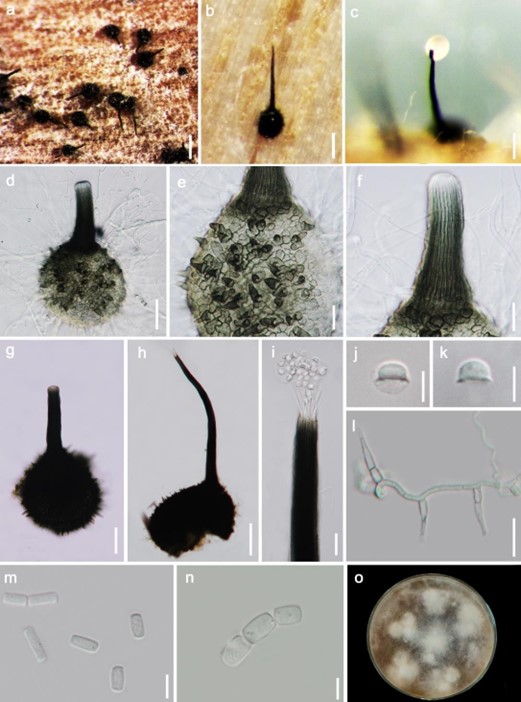Huntiella Z.W. de Beer et al. Stud. Mycol. 79: 211 (2014)
MycoBank number: MB 810236; Index Fungorum number: IF 810236; Facesoffungi number: FoF 08399; 18 morphological species (Species Fungorum 2020), 17 species with sequence data.
Type species – Huntiella moniliformis (Hedgc.) Z.W. de Beer, T.A. Duong & M.J. Wingf.
Notes – Huntiella species occur on a wide range of hosts and are distributed worldwide on Acacia mangium in Indonesia, Eucalyptus obliqua in Australia, E. saligna in South Africa, Mangifera indica in Oman, Picea spinulosa in Bhutan (de Beer et al. 2014), Eucalyptus exserta, Acacia confusa in China (Liu et al. 2018), and Tectona grandis in Thailand (this study). The species are saprobes, weak pathogens and are also commonly found on tree wounds (Mbenoun et al. 2016, Liu et al. 2018). Huntiella chinaeucensis, is illustrated in this entry (Fig. 59).

Figure 59 – Huntiella chinaeucensis (Material examined – THAILAND, Chiang Rai Province, Mae Suai District, Mae Lao garden, on stumps of Tectona grandis (Lamiaceae), 24 December 2012, M. Doilom, MFLU 15-3204). a, b Globose to subglobose ascoma bases with elongated ostiolar necks on Tectona grandis (teak) wood. c Cream-coloured ascospore mass at the tip of the ascoma neck on teak wood. d Immature globose ascoma. e Close up of ascoma base with conical spines. f Ascoma neck with longitudinal striations. g, h Mature ascoma with conical spines on the surface of bases. i Hat-shaped ascospores released through ostiolar hyphae. j, k Hat-shaped ascospores. l Flask-shaped conidiogenous cells. m Bacilliform conidia. n Barrel-shaped conidia in chains. o Colony on PDA. Scale bars: a = 200 µm, b = 300 µm, c = 500 µm, d, g = 50 µm, e, f, l = 20 µm, h, i = 100 µm, j, k, m, n = 5 µm.
Species
